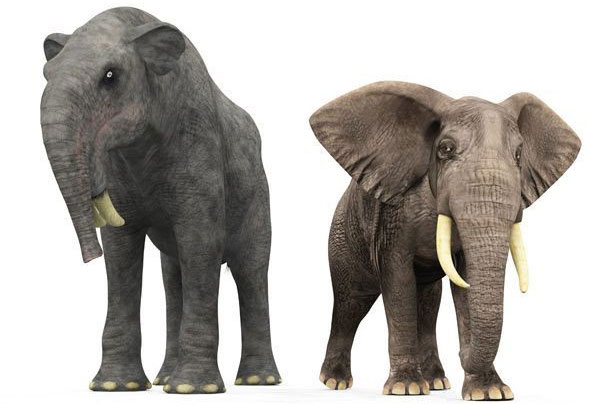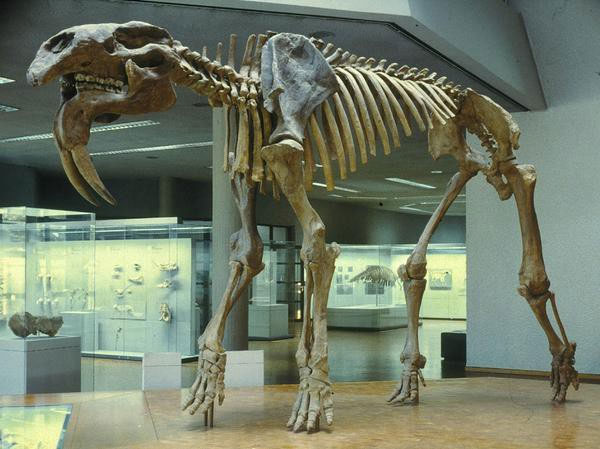The truth is that the ancestors of ancient elephants and rhinos appear to be more 'monstrous' than they are today!
The ancestors of modern elephants are curly-haired mammoths, but if you look further into prehistoric times, their ancestors are extremely strange and seemingly slightly outward looking animals. ".
Deinotherium
Deinotherium, also known as the Terrifying Statue , is one of the oldest ancestors of modern elephants.
The Deinotherium has a similar shape to the African elephant right now, except for its larger body and a pair of ingrown ivory that look quite odd.

The image compares the size of the Deinotherium species to today's African elephant.
In addition, they have a large and relatively short hose if compared to other ancestors of modern elephants or elephants.
According to the size of a skull found in Germany in 1836, we know that these animals far surpass the modern elephants in size from 3.6 to 4.6 m in height, even with males. Giants can reach as high as 5m and the weight can reach up to 12 tons.

Deinotherium's most typical trait is a pair of ivory but it is unclear what their purpose exists for.

Deinotherium is a prehistoric relative of modern elephants today, which appear in the Central Miocene and survive until the Pleistocene period.From the fossil samples discovered, paleontologists think that they have an almost similar behavior with modern elephants and that they have bent fangs attached to the lower jaw.
Platybelodon
The Platybelodon , also known as "shovel elephant" we live about 4-15 million years ago, and are distributed in Africa, Europe, Asia and North America.
This is also a herbivore with relatives of modern elephants, Platybelodon, Archaeobelodon, Konobelodon and Amebelodon, they are all referred to as "ivory elephants" because they share the same function as the lower jaw. The growth of a flattened form with two hard "ivory" also has a flat flattened shape, forming a shovel-like shape.

The biggest difference between the Platybelodon and the elephant is that it has a shovel-shaped shovel.
Previously this species was thought to live in marshy areas on the steppe and use its teeth to expose aquatic plants and semi-aquatic plants.
However, after careful analysis of fossil samples, paleontologists consider that they use fangs to cut and the lower jaw will be used to strip the bark.

It is thought that this species lives in the swamp of grassy steppes, using its teeth to dig up aquatic vegetation and sell aquatic life.
Uintatherium
Uintatherium is an extinct mammal with fossil records discovered in Ford Bray Orange, Utah, USA. It was once believed that it was restricted to what is now North America, but in the 1980s, fossils of this species were found in East Asia.

Male Uintatherium possesses six horns on the forehead, their function is still a mystery so far, but there are many speculations that it is a defensive weapon or tool to show off one's life and attract children. during mating season.
This is a large animal that looks almost like a rhino. The most special feature of this species is that they have an unusually large skull developed - flat and concave skulls - a characteristic not seen in any mammal form.
Uintatherium lived about 33.9 to 55.8 million years ago. Their food is mainly leaves, grass and shrubs.

Fossil bones of Uintatherium species.The species is about 1.6 m tall to the shoulders, 4 m long and can weigh over 2 tons
In addition, they have fast-toothed pairs similar to those of a sword tigers, many claim that this is the defense weapon of this species.
Arsinoitherium
Arsinoitherium is an extinct ungulate, which lives in tropical rainforests and looks like rhinos today, only to have their horns grow in a mysterious way.

Arisinoitherium is an extinct herbivore, similar to the rhino that lived during the late Eocene and Oligocene head in North Africa 36 to 30 million years ago, in the area of tropical rainforest and the edge of the mangrove swamp.

A skeleton of the Arsinoitherium species

So far there has been no exact answer explaining why they have such big big horns on their skulls.
Analysis from fossil samples shows that living beings are 30-36 million years ago with a height of about 1.8 m, 3 m long, although they look quite similar to rhinos, their legs are similar to more elephants, and perhaps their gaits and runs are similar to modern elephants.
- Panic with the most bizarre shapes of prehistoric times
- 9.26m is the maximum length of crocodile ancestors today
- The truth about rhinos and white lions hiding in Binh Duong
- Fossils reveal the ancestors of today's lizards and snakes
- Giant elephants release technology like smoke ... smoking in the forest in India
- The North Pole sinks in the dark winter 53 million years ago
- The truth about Chinese elephants was extinct 3000 years ago
- What do the ancestors of the vegetables we still eat today look like?
- Ancestor 'thirty years old
- Why do the ancient ancestors of human beings walk on two legs?
- Species ancestors who once eat cannibalism
- Statue of War: The horrors of terror of the ancient Persian empire
- The 10 ancient people do better than we do today (Part 1)
 Discovered an ancient centipede fossil 99 million years old
Discovered an ancient centipede fossil 99 million years old Discovered bat-like dinosaurs in China
Discovered bat-like dinosaurs in China Discovered a 200-year-old bronze cannon of the coast
Discovered a 200-year-old bronze cannon of the coast Discover 305 million-year-old spider fossils
Discover 305 million-year-old spider fossils